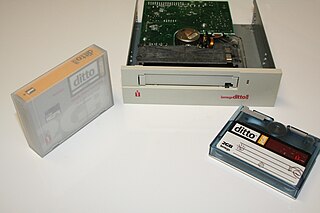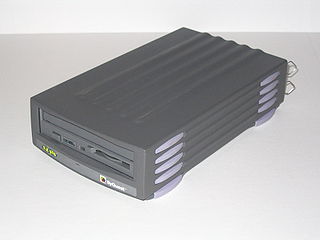
Parallel ATA (PATA), originally AT Attachment, also known as IDE, is a standard interface designed for IBM PC-compatible computers. It was first developed by Western Digital and Compaq in 1986 for compatible hard drives and CD or DVD drives. The connection is used for storage devices such as hard disk drives, floppy disk drives, optical disc drives, and tape drives in computers.

Disk storage is a general category of storage mechanisms where data is recorded by various electronic, magnetic, optical, or mechanical changes to a surface layer of one or more rotating disks. A disk drive is a device implementing such a storage mechanism. Notable types are today's hard disk drives (HDD) containing one or more non-removable rigid platters, the floppy disk drive (FDD) and its removable floppy disk, and various optical disc drives (ODD) and associated optical disc media.

A hard disk drive (HDD), hard disk, hard drive, or fixed disk, is an electro-mechanical data storage device that stores and retrieves digital data using magnetic storage with one or more rigid rapidly rotating platters coated with magnetic material. The platters are paired with magnetic heads, usually arranged on a moving actuator arm, which read and write data to the platter surfaces. Data is accessed in a random-access manner, meaning that individual blocks of data can be stored and retrieved in any order. HDDs are a type of non-volatile storage, retaining stored data when powered off. Modern HDDs are typically in the form of a small rectangular box.
Maxtor Corporation was an American computer hard disk drive manufacturer. Founded in 1982, it was the third largest hard disk drive manufacturer in the world before being purchased by Seagate in 2006.

The ST-506 and ST-412 were early hard disk drive products introduced by Seagate in 1980 and 1981 respectively, that later became construed as hard disk drive interfaces: the ST-506 disk interface and the ST-412 disk interface. Compared to the ST-506 precursor, the ST-412 implemented a refinement to the seek speed, and increased the drive capacity from 5 MB to 10 MB, but was otherwise highly similar.

The Zip drive is a removable floppy disk storage system that was introduced by Iomega in late 1994. Considered medium-to-high-capacity at the time of its release, Zip disks were originally launched with capacities of 100 MB, then 250 MB, and finally 750 MB.

The Bernoulli Box is a high-capacity removable floppy disk storage system that is Iomega's first widely known product. It was released in 1982.
SyQuest Technology, Inc. (Nasdaq: SYQT) was an early entrant into the hard disk drive market for personal computers. The company was founded on January 27, 1982 by Syed Iftikar who had been a founder of Seagate, along with Ben Alaimo, Bill Krajewski, Anil Nigam and George Toldi. Its earliest products were the SQ306R, a 5 MB 3.9" (100 mm) cartridge disk drive and associated Q-Pak cartridge for IBM XT compatibles. Subsequently a non-removable medium version was announced, the SQ306F.

Floptical refers to a type of floppy disk drive that combines magnetic and optical technologies to store data on media similar to standard 3+1⁄2-inch floppy disks. The name is a portmanteau of the words "floppy" and "optical". It refers specifically to one brand of drive and disk system, but is also used more generically to refer to any system using similar techniques.

Iomega was a company that produced external, portable, and networked data storage products. Established in the 1980s in Roy, Utah, United States, Iomega sold more than 410 million digital storage drives and disks, including the Zip drive floppy disk system. Formerly a public company, it was acquired by EMC Corporation in 2008, and then by Lenovo, which rebranded the product line as LenovoEMC, until discontinuation in 2018.

REV is a removable hard disk storage system from Iomega.
IBM manufactured magnetic disk storage devices from 1956 to 2003, when it sold its hard disk drive business to Hitachi. Both the hard disk drive (HDD) and floppy disk drive (FDD) were invented by IBM and as such IBM's employees were responsible for many of the innovations in these products and their technologies. The basic mechanical arrangement of hard disk drives has not changed since the IBM 1301. Disk drive performance and characteristics are measured by the same standards now as they were in the 1950s. Few products in history have enjoyed such spectacular declines in cost and physical size along with equally dramatic improvements in capacity and performance.

A disk enclosure is a specialized casing designed to hold and power hard disk drives or solid state drives while providing a mechanism to allow them to communicate to one or more separate computers.
The Sony HiFD was a high-capacity floppy disk system developed by Sony and Fujifilm and introduced in late 1998. Development and sale of the drives was discontinued by early 2001.

The Ditto drive series was a proprietary magnetic tape data storage system released by Iomega during the 1990s. It was marketed as a backup device for personal computers.
In computing, external storage refers to non-volatile (secondary) data storage outside a computer's own internal hardware, and thus can be readily disconnected and accessed elsewhere. Such storage devices may refer to removable media, compact flash drives, portable storage devices, or network-attached storage. Web-based cloud storage is the latest technology for external storage.

The EZ 135 Drive is a 3.5" removable platter hard disk drive. It was introduced by SyQuest Technology in 1995. It had a maximum capacity of 135 MB per disk.

The Orb Drive is a 3.5-inch removable hard-disk drive introduced by Castlewood Systems in 1999. Its original capacity was 2.2 GB. A later version of the drive was introduced in 2001 with a capacity of 5.7 GB. Manufacturing of this product ceased in 2004.
In 1953, IBM recognized the immediate application for what it termed a "Random Access File" having high capacity and rapid random access at a relatively low cost. After considering technologies such as wire matrices, rod arrays, drums, drum arrays, etc., the engineers at IBM's San Jose California laboratory invented the hard disk drive. The disk drive created a new level in the computer data hierarchy, then termed Random Access Storage but today known as secondary storage, less expensive and slower than main memory but faster and more expensive than tape drives.
Hard disk drives are accessed over one of a number of bus types, including parallel ATA, Serial ATA (SATA), SCSI, Serial Attached SCSI (SAS), and Fibre Channel. Bridge circuitry is sometimes used to connect hard disk drives to buses with which they cannot communicate natively, such as IEEE 1394, USB, SCSI, NVMe and Thunderbolt.













